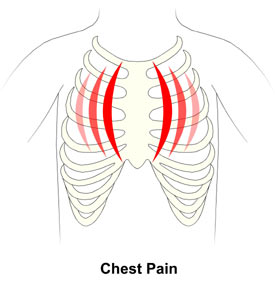
It numerically indicates the probability of a patient having an AMI based on their description of the pain. Likelihood ratios have been calculated in various studies linking features of the history with acute myocardial infarction (AMI) (11-14) (see Table 3). The European Society of Cardiology describes atypical presentations of MI include epigastric pain, indigestion-like symptoms and isolated dyspnoea. NICE defines chest pain as being atypical if only two of these three features are present, or non-anginal if one or none of these exist. Note – According to Chest Pain NICE guideline 95, anginal pain is (1) a constricting discomfort in the front of the chest, or in the neck, shoulders, jaw, or arms that is (2) precipitated by physical exertion, and (3) relieved by rest or GTN within 5 minutes.


When a diagnosis has been reached with the required degree of certainty, management of that condition is covered in the relevant learning session and the patient “drops” out of the algorithm.įigure 1: The diagnostic approach to patients with chest pain

This module is about achieving a diagnosis in a patient presenting with chest pain, not about the treatment of a condition once a diagnosis has been made. The rest will have a specific identifiable cause for their pain that will require a diagnosis and treatment plan during their ED attendance.Ī logical and systematic approach to patients will achieve a diagnosis in the vast majority of cases whilst they are in the ED (see algorithm in the chart click the image to see a larger version).Ī focused history and physical examination supported by an ECG and chest x-ray in most, with some specific ancillary investigations in a few, will allow a firm diagnosis to be made or confident reassurance to be given.Īll of the assessments and investigations discussed in this session are within the remit of the emergency physician and should be available within the ED. Patients attending the ED with chest pain present a classic diagnostic challenge.Ī minority will have an imminently or potentially life-threatening condition and need to be quickly and robustly identified and treated.Ī significant minority will have benign pathology or no significant cause identifiable for their pain and these also need to be identified, reassured and discharged. The diagnostic approach to chest pain in the emergency department Table 1: The spectrum of pathology presenting with chest pain. This is a difficult challenge: it has been reported that 6% of patients discharged from a UK ED have subsequently been proven to have prognostically significant myocardial damage. The large volume of patients presenting with a potentially serious condition places chest pain at the very core of emergency medicine work.Įmergency physicians are responsible for robustly identifying and treating a significant minority of patients with serious pathologies whilst also avoiding unnecessary investigation and admission for the majority of patients who can be safely discharged. Ĭhest pain is caused by a spectrum of pathology ranging from the innocent to the extremely serious (see Table 1) amongst the latter are a number of conditions which are potentially catastrophic and can cause death within minutes or hours. Acute chest pain is a common presenting complaint: it accounts for approximately 700 000 presentations to the emergency department (ED) per year in England and Wales and for 25% of emergency medical admissions.


 0 kommentar(er)
0 kommentar(er)
